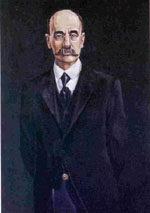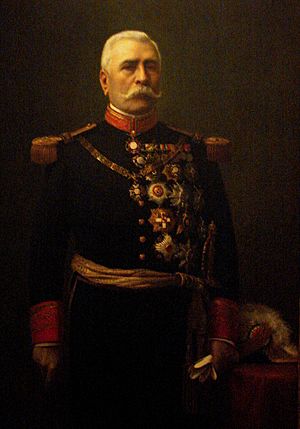Federico Gamboa facts for kids
Quick facts for kids
Federico Gamboa
|
|
|---|---|
 |
|
Lieutenant Secretary of Foreign Relations of Mexico In charge of Office |
|
| In office April 1910 – May 1910 |
|
| President | Porfirio Díaz |
Secretary of Foreign Affairs |
|
| In office 11 August 1913 – 24 September 1913 |
|
| President | Victoriano Huerta |
| Personal details | |
| Born | December 22, 1864 Mexico City |
| Died | August 15, 1939 (74 years) Mexico City |
| Spouse | María Sagaseta |
Federico Gamboa Iglesias (born December 22, 1864, in Mexico City; died August 15, 1939, in Mexico City) was a famous writer and diplomat from Mexico. He is known as one of the best writers of a style called Naturalism in Mexico.
Gamboa wrote many different types of works. These included novels, plays for the theater, and articles for newspapers and magazines. He also wrote an autobiography when he was 28 years old. For many years, he kept detailed notes about his travels, experiences, and thoughts. He later published these notes as five diaries. After he passed away, two more volumes of his diaries were published.
Contents
Federico Gamboa's Early Life and Career
Federico Gamboa started studying to become a notary at the National School of Law. However, his parents both passed away, and he had to leave school in 1884. He then began working as an assistant in a Civil Court. At the same time, he started his career as a journalist.
He wrote a regular article for El Diario del Hogar newspaper. This column was called Desde mi mesa (which means From my table). He used the pen name «La Corcadiere» for these articles. Even though he was doing well, he wanted more. So, he decided to join the public service.
Becoming a Mexican Diplomat
After passing all the necessary tests, Gamboa joined the Mexican Foreign Affairs Service. This happened on October 9, 1888, when he was 24 years old. His first assignment was in Guatemala. After that, he worked for the Mexican Embassy in Argentina.
Later, from August 12 to September 24, 1913, he served as the Secretary of Foreign Affairs. This is a very important job, like being the head of a country's international relations. He held this position for only 44 days. He left to run for president of Mexico, representing the National Catholic Party. He ran with General Eugenio Rascón as his vice president. However, he lost the election to Victoriano Huerta.
Life During the Porfiriato Era

Federico Gamboa is famous for being one of the most important Mexican novelists during the time of Porfirio Díaz. This period is known as the Porfiriato. José Emilio Pacheco, another writer, said that Gamboa "found his place in the Porfirian society." Gamboa always looked for a good life, and being part of Porfirio Díaz's government was very important to him. He felt it was his destiny.
However, the Mexican Revolution changed everything. Porfirio Díaz left office in May 1911. Gamboa was in Europe at the time and even met Díaz there. He was able to keep his job as an ambassador in the Netherlands.
During Victoriano Huerta's presidency, Gamboa was asked to lead the Secretariat of Foreign Affairs. He held this role for 44 days before leaving to run for president, but he lost to Huerta. His return to Mexico marked the end of his comfortable life as a public servant.
Leaving Mexico During the Revolution
During Venustiano Carranza's presidency, Gamboa had to leave Mexico. He went with his wife, María Sagaseta, and their only child. They first traveled to the United States. Then, they moved to La Habana, Cuba, where they lived from 1914 to 1919.
Federico Gamboa's Published Works
Federico Gamboa was a very productive writer. He created many novels, plays, and articles.
Novels
Here are some of his well-known novels:
- Del natural. Esbozos contemporáneos. (1889)
- Apariencias (1892)
- Suprema Ley (1896)
- Metamorfosis (1899)
- Santa (1903)
- Reconquista (1908)
- La llaga (1913)
- El evangelista: a novel about Mexican customs (1922)
Autobiography and Diaries
Gamboa also wrote about his own life and experiences:
- Impresiones y recuerdos (1893)
- Mi Diario. Primera Serie I: 1892–1896 (1908)
- Mi Diario, Primera Serie II: 1897–1900 (1910)
- Mi Diario, Primera Serie III: 1901–1904 (1920)
- Mi Diario, Mucho de mi vida y algo de la de otros, Segunda Serie I: 1905–1908 (1934)
- Mi Diario, Mucho de mi vida y algo de la de otros, Segunda Serie II: 1909–1911 (1938)
- Mi Diario VI (1912–1919) Mucho de mi vida y algo de la de otros (1995) – Published after his death.
- MI Diario VII (1920–1939) Mucho de mi vida y algo de la de otros (1996) – Also published after his death.
Plays for the Theater
His plays include:
- La última campaña (1894): a social comedy that opened in Mexico City.
- Divertirse (1894): a monologue that opened in Mexico City.
- La venganza de la Gleba (1904)
- A buena cuenta (1907): a drama that opened in Mexico City in 1914.
- Entre hermanos (1925): a tragedy that opened in Mexico City in 1928.
Journalism Work
Gamboa was also active in journalism:
- (1884) He was a proofreader for El Foro, a law journal.
- (1885–1887) He worked as a reporter and writer for El Diario del Hogar.
- (1886) He started his own column called Celajes de la ópera, later renamed Desde mi mesa.
- (1888) He wrote for El Lunes and began signing articles with his real name.
- (1894–1895) He published articles in El Mundo with Ángel de Campo.
- (1915–1917) He was a writer and interim director for La Reforma Social magazine in La Habana, Cuba.
- (1926–1939) He wrote a weekly article for El Universal newspaper.
Essays
Some of his essays include:
- La novela mexicana (1914): a conference he gave about Mexican novels.
- La confesión de un palacio: an essay about Mexican history.
- Un baile en Palacio: written with Gustavo Baz (1887).
Movies Based on His Novels
Several of Federico Gamboa's novels have been turned into movies:
- Suprema Ley (1896): This novel was made into a movie in 1936. It starred Andrés Soler.
- Santa (1903): This is one of his most famous novels and has been made into a movie four times in Mexico!
- The first was a silent film in 1918.
- A famous version was made in 1932, directed by Antonio Moreno. It featured a song by Agustín Lara and starred Lupita Tovar. This movie is considered one of the best 100 films ever made in Mexico.
- Another version came out in 1943.
- The latest Mexican version was directed in 1969.
- There was also a Spanish version in 1991 and a free adaptation in 1949.
- La Llaga (1913)
- Entre Hermanos (1928): This play was made into a movie in 1945. It starred famous actors like Pedro Armendáriz and Carmen Montejo.
Images for kids
-
Porfirio Díaz, president of Mexico.
See also
 In Spanish: Federico Gamboa para niños
In Spanish: Federico Gamboa para niños


